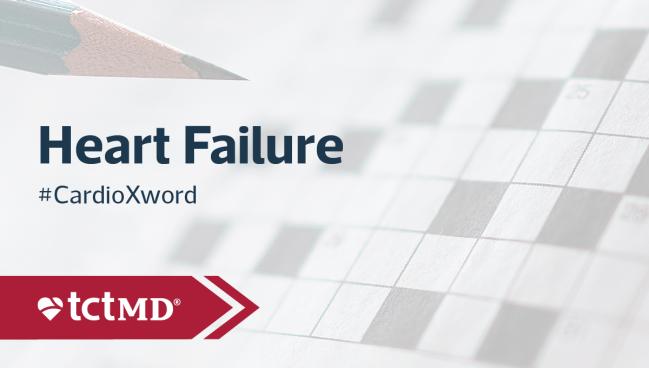Top Heart Failure News of 2024
Newer therapies for multiple conditions were major stories this year, but long-term HF survival gains seem to have vanished.

Glucagon-like peptide-1 (GLP-1) receptor agonists—wildly popular for weight loss—continued to demonstrate their impact in HF (7 Across) this year. In the STEP-HFpEF DM trial (STEPHFPEF; 49 Across), for instance, once-weekly semaglutide (Wegovy; Novo Nordisk) improved symptoms and physical function in patients with obesity-related HFpEF and type 2 diabetes. Those gains came despite patients losing less weight than participants in the earlier STEP-HFpEF trial, which excluded patients with known diabetes.
And results of the SUMMIT trial—reported last month at the American Heart Association (AHA) 2024 Scientific Sessions—showed that tirzepatide (Zepbound; Eli Lilly), a dual glucose-dependent insulinotropic polypeptide (GIP) and GLP-1 receptor agonist, significantly reduced the risk of cardiovascular mortality and worsening heart failure events in patients with obesity and HFpEF.
Though the potential is there for these medications to have a positive impact on HF outcomes, other research shows that many patients fail to stay on them over the long term, with high out-of-pocket costs and side effects playing a major role. Whether the benefits of the drugs are worth the high costs is not a straightforward question.
Other News in HF
Outside of HFpEF, there were promising results of medical therapy in other conditions as well. For ATTR-CM, vutrisiran (3 Down), a novel “silencer” agent sold under the brand name Amvuttra (Alnylam) for the treatment of polyneuropathy of hereditary transthyretin-mediated amyloidosis, lowered the risk of all-cause mortality or recurrent cardiovascular events versus placebo in the HELIOS-B trial. The benefits were seen both in the overall population and among patients not on background tafamidis (Vyndaqel and Vyndamax; Pfizer), the first drug approved for ATTR-CM by the US Food and Drug Administration.
Just last month, the FDA approved a second drug for ATTR-CM—acoramidis (Attruby; BridgeBio)—with support from the findings of the ATTRibute-CM trial.
For patients with obstructive HCM (7 Down), aficamten, an investigational cardiac myosin inhibitor, delivered positive results in the SEQUOIA-HCM trial. The main results, released at the European Society of Cardiology’s Heart Failure 2024 Congress in May, showed aficamten (Cytokinetics) boosted peak oxygen uptake and other indicators of health status compared with placebo. A subsequent post-hoc analysis suggested gains across multiple measures of clinical response.
We have more treatments and more effective therapies for heart failure than we’ve ever had, but at the same time, we’re seeing some worrisome trends. G. Michael Felker
Also in May, the AHA, the American College of Cardiology, and several other professional societies released updated HCM guidelines, prompted by the 2022 FDA approval of another cardiac myosin inhibitor, mavacamten (Camzyos; Bristol Myers Squibb), for the treatment of symptomatic obstructive HCM.
Moreover, finerenone (35 Down), a nonsteroidal mineralocorticoid receptor antagonist (MRA) sold as Kerendia (Bayer AG) for adults with chronic kidney disease associated with type 2 diabetes, lessened the risk of worsening HF events and cardiovascular mortality in patients who had heart failure with mildly reduced or preserved ejection fraction (HFmrEF or HFpEF) in the FINEARTS-HF trial.
MRAs are, of course, an integral component of guideline-directed medical therapy (GDMT; 44 Down) for patients with heart failure with reduced ejection fraction (HFrEF). Numerous studies show that uptake of all four pillars of GDMT remains poor, with clinical inertia shouldering much of the blame, and there are a host of ideas for improving the situation.
In other medication news, drugs used to treat attention-deficit/hyperactivity disorder (ADHD; 46 Across) were linked to cardiomyopathy in young adults and sacubitril/valsartan (Entresto; Novartis), an angiotensin receptor-neprilysin inhibitor (ARNI; 21 Across), helped protect against cardiotoxicity related to anthracycline chemotherapy in high-risk patients with cancer, according to the results of the SARAH trial.
Beyond pharmacotherapy, also making news in 2024 was the sham-controlled RELIEVE-HF trial (RELIEVEHF; 12 Across), in which the Ventura interatrial shunt (V-Wave), though safe, did not improve prognosis or reduce symptoms across a range of patients with HF. There appeared to be a beneficial effect in patients with HFrEF but potential harm in those with HFpEF.
A Concerning Trend
Heart Failure Society of America (HFSA) President G. Michael Felker, MD (Duke University, Durham, NC), reflected on the year in heart failure for TCTMD, highlighting the trials of finerenone and the GLP-1 receptor agonists as major positive developments.
There was, however, some concerning news that came out earlier this year, he said, alluding to a study published in April showing that years of progress in reducing HF mortality may have been erased in the current era, with HF mortality higher now than in 1999.
“That’s a complicated issue. There are a lot of opinions about whether that’s a real thing versus just related to the way things like cause of death are captured and recorded and coded,” Felker said. “But certainly, I think it goes along with other trends we see in worse outcomes for patients with chronic diseases like heart failure.”
There’s some irony there because “we have more treatments and more effective therapies for heart failure than we’ve ever had, but at the same time, we’re seeing some worrisome trends in the way mortality has changed,” he added, speculating that continuing challenges in optimization of GDMT for HFrEF could be contributing.
HFSA issued a report earlier this year that writing committee chair Biykem Bozkurt, MD, PhD (Baylor College of Medicine, Houston, TX), deemed a “call to action” against the growing problem of HF in the United States, with sharp increases in incidence in younger people, those from racial/ethnic minority groups, and those with comorbid conditions.
Despite some alarming trends, Felker indicated that the heart failure community is in a good place in terms of being able to offer patients multiple treatment options.
“I always tell people that when I started doing this 20 years ago, we had pretty limited options for what to do for patients,” he said. “Our problem now is we have so many options that deciding which one and what order and what combination is really the biggest challenge, which is a very nice difference from trying to figure out what to do when you didn’t have very many good things to offer. So over 20 years, I think we’ve seen a dramatic change in the heart failure landscape, and I suspect that will continue.”
Todd Neale is the Associate News Editor for TCTMD and a Senior Medical Journalist. He got his start in journalism at …
Read Full BioDisclosures
- Felker reports no relevant conflicts of interest.





Comments